
.
.

Located on the River Mulde between Leipzig and Dresden is the city of Grimma. With a population of 28,700 inhabitants, Grimma is geographically located at the junction of the flat lands to the north and the hills and lakes region to the south. The name is of Sorbian origin and means a region that is at or below sea level, surrounded by water. The city has had its share of flooding in its 1000+ year history, but for each disaster it faces, it emerges bigger and better than before. It has survived six floods plus the bombings of the second World War only to become a more attractive community for people to live. Much of Grimma’s architecture today either originates from the Baroque period or mimick’s that because the original was destroyed. Grimma’s city center has many small shops in historic buildings that are over two centuries old. The historic city hall is one of them. The largest building in the city is the St. Augustin, a combination of high school and chuch located along the Mulde. To the south of the city near the dam is the castle, where the Margraves of Meissen and the Electors of Saxony once resided. Grimma is the largest city along the River Mulde in Saxony and is a major stop for cyclists riding along the Mulde. In terms of land size, it’s the fourth largest in the state of Saxony. And when it comes to bridges, Grimma has a storied history behind two of the city’s most popular attractions.
Eight bridges within a radius of 10 kilometers can be found in Grimma, including the Motorway 14 Bridge and a bridge south of Grimma at Grossboden, all but two spans the River Mulde. Yet the most important of the city’s bridges are the Grimma Suspension Bridge and the Poppelmann Arch Bridge because of its history of being rebuilt after each disaster and also because of their unique designs. These two bridges, plus an arch bridge along a former railroad line, the arch bridge at Grossboden and the Mill Run Bridge will be featured in the Top Five Bridge Pics when visiting Grimma. The other bridges will be mentioned in one way or another in reference to the bridges profiled here in this tour guide.
So without further ado, let’s have a look at the bridges in Grimma and find five bridge reasons to convince you to visit this fine community.
Poppelmann Arch Bridge
Location: Mulde River at Volkhausplatz and Muldenufer
Type: Stone arch bridge with tubular steel arch main span. Five arch spans exist.
Built: 1719 replacing earlier spans dating back to 1292. Rebuilt seven times, the last being in 2012
Length: 143 meters, 7.3 meters wide
.
The Poppelmann Bridge has perhaps one of the most storied histories of bridge building not only in Saxony, but on the international front. Its first crossing dates back to the 13th Century. Counting the reconstruction in 2021, it has been rebuilt at least ten times in over 900 years of its existence. It was built and rebuilt using at least five different bridge types: arch bridge, covered bridge, metal truss bridge, suspension bridge and modern beam bridge. It is also considered one of the most ornamental bridges in Saxony, as today’s bridge is covered with ornamental lighting, and has a Baroque-style shield representing Saxony. To go into detail about the bridge would require a separate article but there is a book that was written about this bridge that was published in 2017. But to give you some facts about this bridge:
.
The bridge in its current form was constructed in 1719 by Mathias Poppelmann. It was the fourth crossing at this location as the previous ones were destroyed either during warfare or flooding. For almost a Centruy before Poppelmann built this bridge, there was no crossing and attempts to garner support had failed. Mr. Poppelmann had left his signature in bridge building in Saxony, which included not only the construction of the Augustus Bridge in Dresden, but also the Poppelmann design, where the covered bridge is the main span and the approach spans are made of red stone arch. Dozens were built in Saxony during his time as bridge engineer, yet sans covered bridge, only two of his examples exist today, here and in Waldheim. The Poppelmann Bridge in his current form had existed for over 170 years with the covered bridge having been rebuilt in 1816, three years after it was destroyed during the war with Napoleon.
In 1894, in response to the increase in traffic, the bridge was rebuilt. The covered bridge was replaced with a Schwedler pony truss span while the arches were strengthened. It was in service until the span was imploded by the fleeing Nazi troops on 15 April, 1945. It was rebuilt with an improvised suspension bridge right after the war, but was replaced with a deck truss bridge two years later. The bridge was extensively rehabbed in 1972 which included a permanent deck truss span. It remained in service until 1996 when the bridge was rehabbed again, this time with a concrete deck arch center span. At the same time, a taller span was constructed, located 100 meters north of the structure, which has been serving traffic ever since. The historic bridge was reopened in 1999 but little did the City of Grimma realize that a flood of biblical proportions would cause massive destruction to much of the city and this bridge.
.
On August 13, 2002, massive floodwaters caused extensive damage to the bridge. The newly built center span was dislodged from the bridge and was washed away. The two arches that had supported the main span was damaged to the point that they were not salvageable. The bridge was rebuilt from the bottom up, rebuilding the arches that could be saved and removing the ones that were not. A new center span, featuring a tubular arch design, was chosen as its replacement. On August 12, 2012, after a three-year project, the bridge was reopened to pedestrians and cyclists. It survived the 2013 floods unscathed, while other areas to the north of Grimma was affected the worst.
Today’s Poppelmann Arch Bridge is open to pedestrians and cyclists and is conveniently located next to the parking lot that accommodates visitors to the shopping center and sports complex. The Poppelmann Bridge is the best accessory to Grimma’s city center as it presents a backdrop to the historic buildings that exist on the western side of the river, including the St. Augustin and the historic City Hall.
More on the bridge, including historic photos and the like here: http://www.poeppelmannbruecke.de/
Grimma Suspension Bridge
Location: Mulde River at Colditzer Weg and Bärenburg Castle
Type: All-steel wire suspension bridge
Built: 1924, rebuilt in 1949 and again in 2004
Length: 80 meters
The Grimma Suspension Bridge can be easily accessed by both car as well as through the Mulde Bike Trail as both run along the river. The bridge itself is the longest suspension bridge in Saxony and is one of six suspension bridges along the Mulde/ Zwickau Mulde. The suspension bridge is a photographer’s paradise as it presents a beautiful backdrop from both sides of the river. On the west side of the river is Bärenburg Castle located on the hill. Two eateries and a hotel are located nearby. On the east end is nothing but nature as the city park and forest cover much of the eastern side of the Mulde. The bridge is located 30 meters from the dam and one could find a perfect side view from that area, with or without the dam. The bridge is unique as the entire structure is all built using steel. The roadway is supported by Warren trusses which even curves around the western entrance. The cables and suspenders are all wired and pin-connected. The towers have three different portals with a V-laced bracing at the top, followed by vertical beams and lastly an A-frame portal bracing whose bottom endpost extends to the bridge deck. It’s one of the most ornamental of bridges in Saxony, competing with the likes of neighboring Poppelmann Bridge, the Blue Miracle Bridge in Dresden and the Paradiesbrücke upstream in Zwickau.
The bridge has survived a bombing attack before the end of World War II as well as several flooding events, among others, in 1954, 2002 and 2013. It has been rebuilt twice: in 1949 and again after the flood disaster in 2004. Repairs were made in response to the flood damage two years earlier and the bridge reopened again in 2015. Located near the dam, a memorial was erected in 2006 that was dedicated to the Great Flood in 2002 with people who risked their lives to save many others, some of which were profiled in newspapers and magazines.
.
.
Rabenstein Railroad Bridge (now extant)
Location: River Mulde south of the Grimma Suspension Bridge at the Rabenstein Observation Point
Type: Metal Through Truss Bridge
Built: 1876 (first crossing); replaced in 1931; destroyed in 1945; removed afterwards
When biking south along the Mulde bike trail, one will find piers and abutments of a bridge that once existed. The Rabenstein Bridge was built as part of the construction of a rail line that connected Grimma with Grossboden. The original railroad station was located adjacent to the market square. The original span, built in 1876, featured a two-span Schwedler through truss with skewed portal bracings. How the portals looked like remains unclear, but post card photos reveal how the end posts are skewed at the piers.
Because of the increase in rail traffic and the structural weakness of the bridge, the spans were replaced by multiple-span Warren through truss bridges in 1931, built with riveted connections and with I-beam portal bracings supported by heels. All but the easternmost span were imploded in April 1945 by the Nazis in an attempt to slow the advancement of Russian and American troops from the east. Grimma came under Soviet control and eventually became part of East Germany by 1949. Because of chronic material shortage, rail lines and bridges deemed expendable were removed with the steel recycled and reused for other purposes. That was the case with the rail line as it was relocated to the western side of the Mulde and up the hill making the original line useless. A new station at Leipziger Strasse near the city center was constructed which still operates to this day. The tracks of the old line and the remaining span were both removed in the 1960s, though when exactly it happened is unknown. The Mulde Bike Trail now uses the track remains along the eastern side of the river.
.

Mulde Bike Trail Arch Bridge
Location: Small hiking path near the Grimma Dam and Suspension Bridge
Type: Stone Arch Bridge
Built: 1876
This bridge is hard to find, unless you happen to hike the trails in the city forest on the eastern side of the River Mulde. It is unknown who was behind the design and construction of this short crossing, which is no longer than 10 meters long and 3 meters high, but it was once part of the railroad line that had passed through Grimma until 1945. It’s now a rail-to-trail that is part of the Mulde Bike Trail. When going under the bridge towards the dam, one must pay attention to the mud that exists, partially because of the water run off from the hills into the river, 30 meters away.
.
.
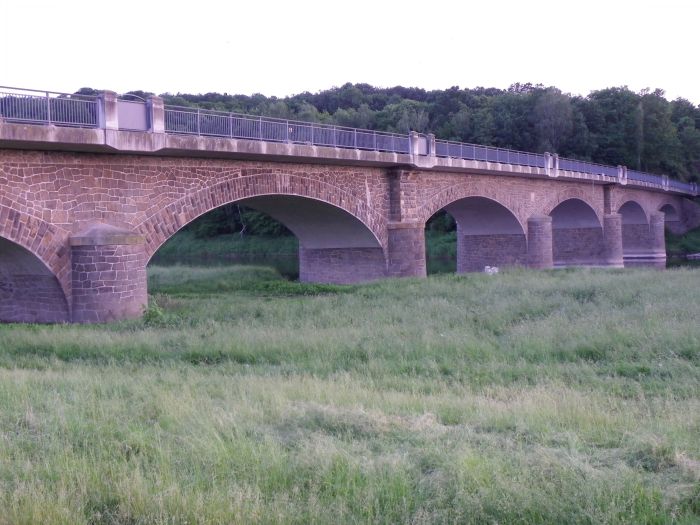
Kössern Bridge
Location: Mulde River near Grossboden
Bridge Type: Eight-span stone arch bridge
Built: 1887-88
Dimensions: 142.5 meters long, 22.5 meters wide
As a bonus, one should drive 6 kilometers south along the Mulde to this bridge. This bridge is easy to photograph as there is plenty of grass land on the eastern side of the river which makes it perfect for a photo with a heavily-forested background. The bridge is located only two kilometers from the train station in Grossboden, which serves train traffic to this day between Leipzig and Freiberg via Grimma and Wurzen. The bridge is the first roadway crossing over the Mulde north of the confluence between the Zwickau and Freiberg Mulde at Sermuth. Not far from the bridge is an abandoned railroad bridge made of girder spans.
.
Fazit:
Grimma is a quick stop for a visit, with many possibilities to satisfy travelers for a good hour or so. If you are a pontist, the city has two historic bridges with a storied history in the Suspension and Poppelmann Bridges and three more bridges whose history belongs in the books and are worth a visit. It’s a junction between a well-traveled bike trail and some well-travelled highways. Speaking from experience of spending a couple hours there with my family, Grimma is worth the stop no matter where you go. 🙂
.
.
Author’s Note: A Biography on Mathias Poppelmann will appear in the next year as the author is currently collecting some bridge examples that were built by the engineer, namely the Poppelmann Bridges with the combination covered bridge with stone arch approaches. If you know of some postcards, photos and other information on these bridges, feel free to use my contact form (here) and send it over. Thank you for your help in this matter. 🙂
.



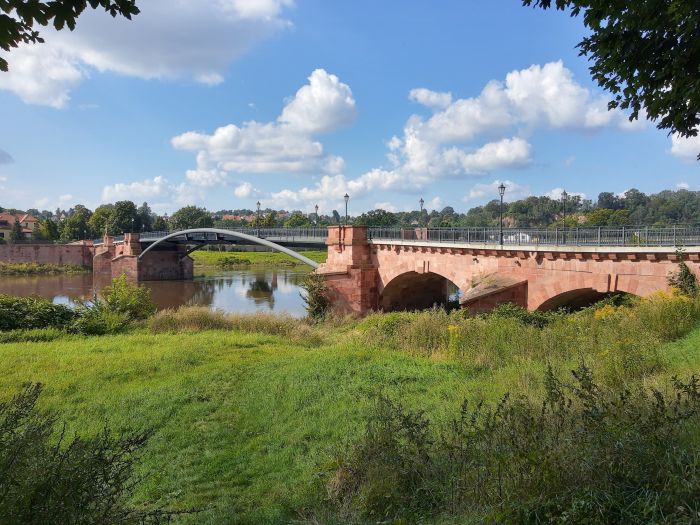


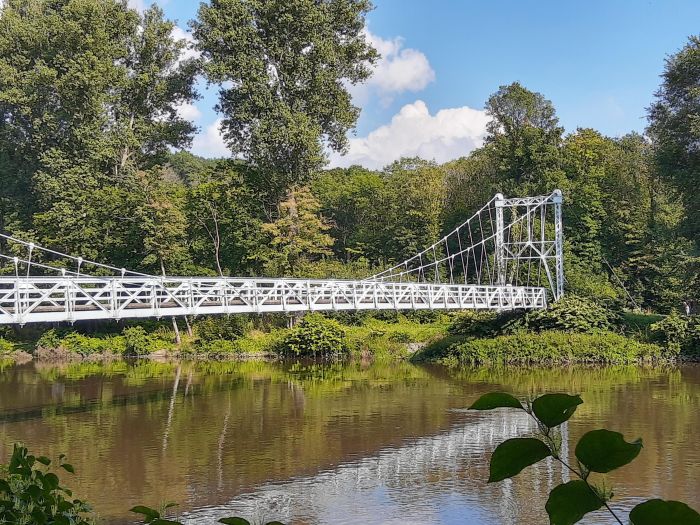

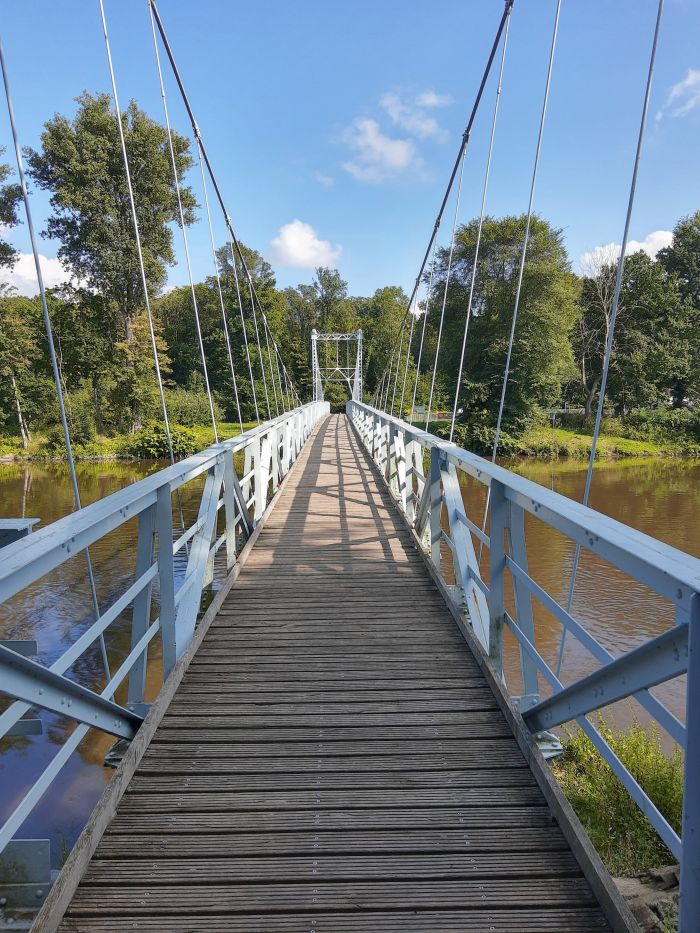




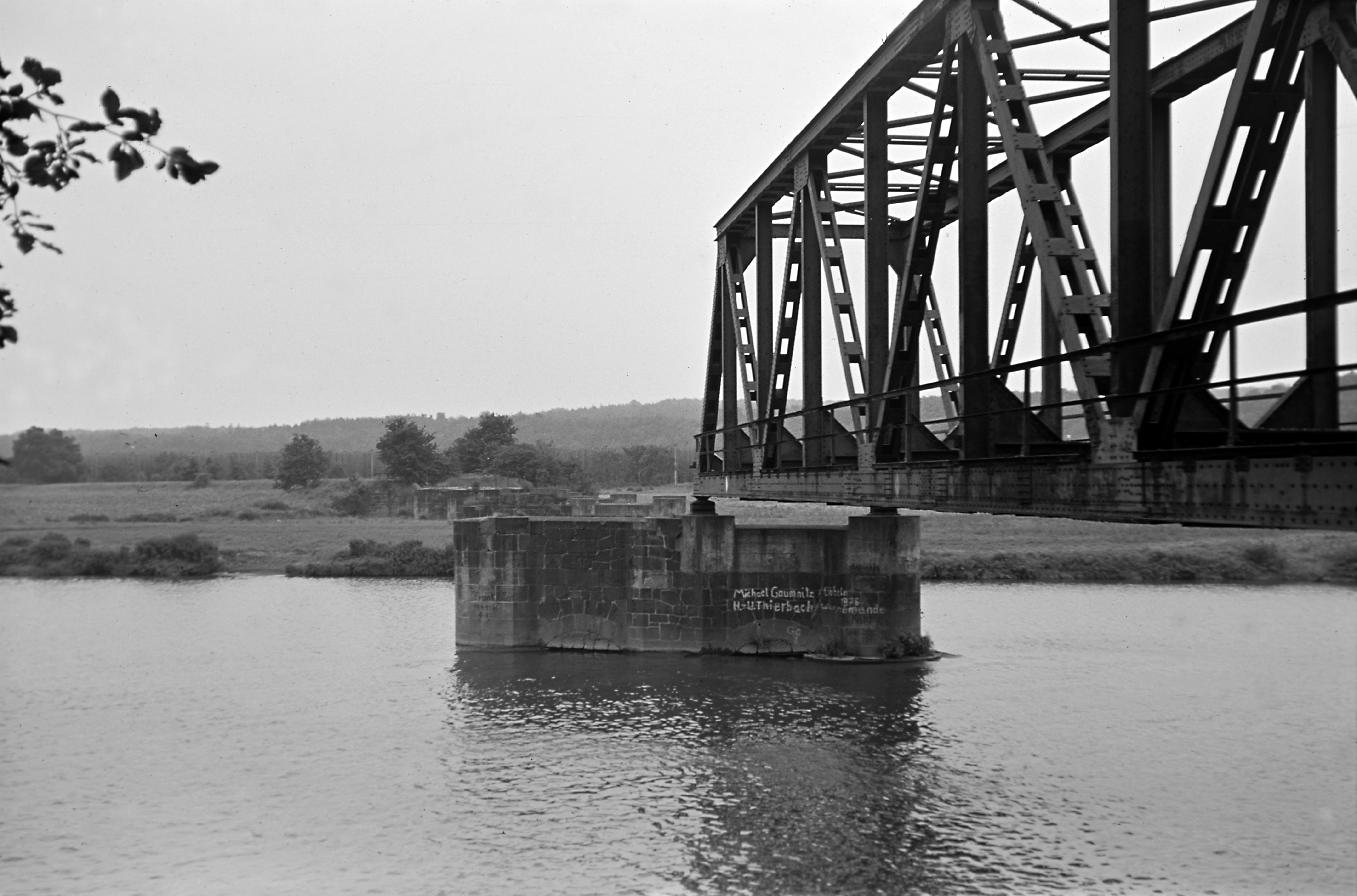
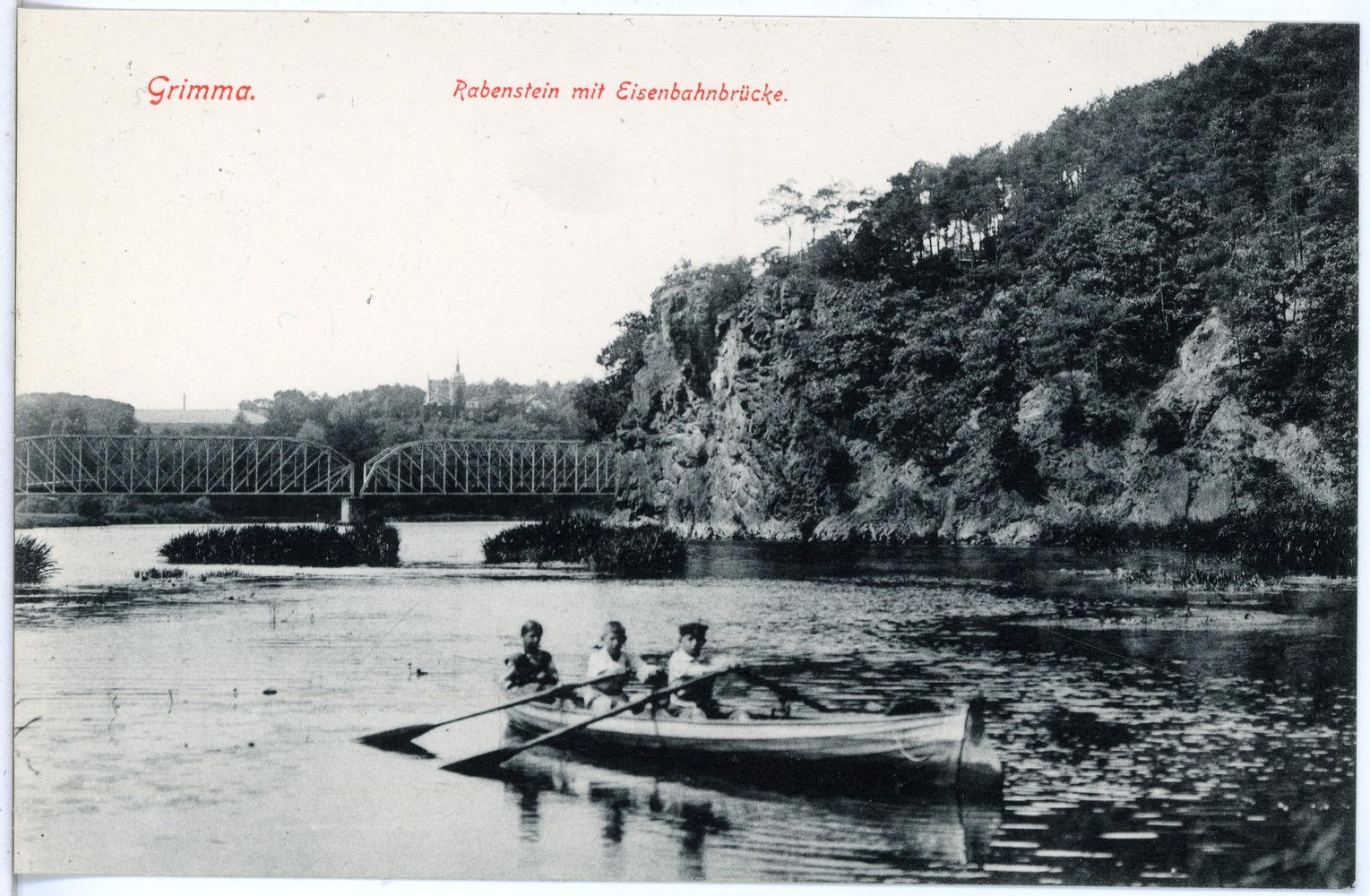

2 thoughts on “The Bridges of Grimma (Saxony), Germany”